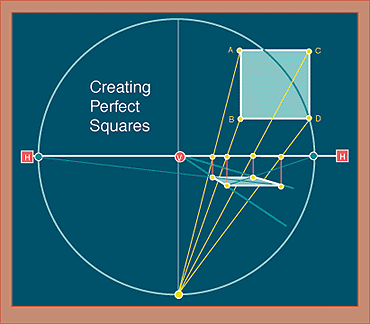- In order to faithfully reproduce anything in linear perspective it
is important to establish a cone
of vision. We have done this in the diagram by creating a perfect
circle whose center is the vanishing point. A larger cone of vision
works better and helps to eliminate distortions.
- We should also establish a vertical axis. This axis will help us to
establish placement of the perspective square in the space.
- Next we can place a square somewhere adjacent to the circle of
vision. It can be placed anywhere, but its placement will dictate
where the perspective square will fall. If the square is close to the
horizon line, then the perspective square will be smaller and further
back in the space. If further from the horizon line, then it will be
larger and closer to the viewer. It should always be inside or at
least touching the cone of vision. If it is placed below the horizon,
the perspective square will be drawn above and vice versa.
- Now draw lines from each of the four corners of the square (marked
A, B, C, and D in the diagram) to either top or bottom of the axis
line where it intersects the cone of vision. The establishment of the
point will depend on whether your square is placed above or below the
horizon line. Remember that the drawn square will be drawn in the
opposite semi-circle.
- At the points where A, B, C, and D intersect the horizon line, lines
will be drawn vertially or perpendicular to the horizon line. This is
illustrated with four red lines that drop vertically from those four
intersections.
- Now the square will begin taking shape when you draw two diagonals
from the points on the cone of vision where they intersect with the
horizon line. These two points are on the right and left of the
vanishing point toward the far end of the horizon line. They are
marked in green. At the points where these diagonals intersect the
verticals (marked with yellow dots) you will establish the perspective
square.
- Points A and C represent the back edge of the square (they are
further from the horizon line) and B and D represent the front.
This should establish a convincing square that appears to recede into
space. To check your work, make sure that the diagonal lines which emanate
from the edges of the cone of vision intersect the corners of the square.
Also check to make sure that the right and left edges recede back to the
vanishing point. You can also check a square that you have approximated by
reversing this process. I also recommend good observation of a real space
to compliment this process.
I would like to thank Ward Walker, Jr. of Austin Community College for
his question about creating a square in perspective.
|
![]()
